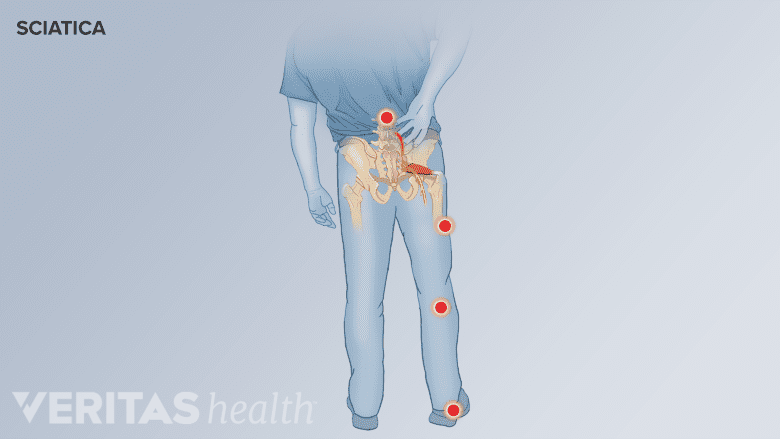Sciatica is a term used to describe nerve pain in the leg that is caused by irritation and/or compression of a sciatic nerve root.
Sciatica originates in the lower back, radiates deep into the buttock, and travels down the leg. The pain may be accompanied by numbness and/or weakness.
Common Symptoms of Sciatica

Sciatica symptoms typically affect one side of the body.
The symptoms of sciatica are commonly felt along the path of the large sciatic nerve. Sciatica is often characterized by one or more of the following features:
- Pain. Sciatica pain is typically felt like a constant burning sensation or a shooting pain starting in the lower back or buttock and radiating down the front or back of the thigh and leg and/or feet.
- Numbness. Sciatica pain may be accompanied by numbness in the back of the leg. Sometimes, tingling and/or weakness may also be present.
- One-sided symptoms. Sciatica typically affects one leg. The condition often results in a feeling of heaviness in the affected leg.1Davis D, Vasudevan A. Sciatica. [Updated 2019 Feb 28]. In: StatPearls [Internet]. Treasure Island (FL): StatPearls Publishing; 2019 Jan-. Available from: https://www.ncbi.nlm.nih.gov/books/NBK507908/. Rarely, both legs may be affected together.
- Posture induced symptoms. Sciatica symptoms may feel worse while sitting, trying to stand up, bending the spine forward, twisting the spine, lying down, and/or while coughing. The symptoms may be relieved by walking or applying a heat pack over the rear pelvic region.
See Understanding Sciatica Symptoms: Pins and Needles, Numbness, Icy, and Burning
It is important to note that any type of lower back pain or radiating leg pain is not sciatica. Sciatica is specific to pain that originates from the sciatic nerve.1Davis D, Vasudevan A. Sciatica. [Updated 2019 Feb 28]. In: StatPearls [Internet]. Treasure Island (FL): StatPearls Publishing; 2019 Jan-. Available from: https://www.ncbi.nlm.nih.gov/books/NBK507908/.
In This Article:
- What You Need to Know About Sciatica
- Sciatica Symptoms
- Sciatica Causes
- Diagnosing the Cause of Sciatica
- Sciatica Treatment
- Sciatica Surgery
- Sciatica Causes and Symptoms Video
Main Causes of Sciatica

Herniated discs are the most common cause of sciatica.
Sciatica is a term used to describe a set of symptoms caused by an underlying medical condition; it is not a medical diagnosis.2Cook CE, Taylor J, Wright A, Milosavljevic S, Goode A, Whitford M. Risk Factors for First Time Incidence Sciatica: A Systematic Review. Physiotherapy Research International. 2013;19(2):65-78. doi:10.1002/pri.1572.
Common medical conditions that may cause sciatica include1Davis D, Vasudevan A. Sciatica. [Updated 2019 Feb 28]. In: StatPearls [Internet]. Treasure Island (FL): StatPearls Publishing; 2019 Jan-. Available from: https://www.ncbi.nlm.nih.gov/books/NBK507908/.:
- A herniated lumbar disc
- Lumbar spinal stenosis
- Lumbar degenerative disc disease, general degenerative changes in vertebrae or discs
- Spondylolisthesis
- Muscle spasm and/or inflammation of the lumbar and/or pelvic muscles
- Sacroiliac joint dysfunction
Rarely, tumors, blood clots, or other conditions in the lower spine may cause sciatica.
Read more about Sciatica Causes
In addition to the terms that identify the underlying pathologies that cause sciatica, the terms lumbar radiculopathy or radicular pain may be used interchangeably with the term sciatica.
The Sciatic Nerve and Sciatica
The sciatic nerve is the largest single nerve in the body and is formed by the union of 5 nerve roots in the lumbar and sacral spine. There are 2 sciatic nerves in the body—the right and left nerves, supplying the corresponding lower limb.
A few anatomical characteristics of the sciatic nerve include:
- Origin. Starting at the level of the spinal segment L4, the sciatic nerve is formed by the merging of spinal nerves roots from L4 to S3.3Giuffre BA, Jeanmonod R. Anatomy, Sciatic Nerve. [Updated 2018 Dec 16]. In: StatPearls [Internet]. Treasure Island (FL): StatPearls Publishing; 2019 Jan-. Available from: https://www.ncbi.nlm.nih.gov/books/NBK482431/. The emerging nerve roots converge into a single sciatic nerve making it large and bulky, typically up to 2cms in diameter.1Davis D, Vasudevan A. Sciatica. [Updated 2019 Feb 28]. In: StatPearls [Internet]. Treasure Island (FL): StatPearls Publishing; 2019 Jan-. Available from: https://www.ncbi.nlm.nih.gov/books/NBK507908/.
- Path. After its individual contributions end, the sciatic nerve exits the pelvis through the greater sciatic foramen, below the piriformis muscle. The nerve then runs along the back of the thigh, into the leg, and finally ends in the foot.
- Branches. The sciatic nerve branches into 2 main divisions behind the knee—the tibial nerve and the common peroneal nerve. The tibial nerve courses down and supplies the back of the leg and the sole of the foot. The common peroneal nerve supplies the front of the leg and foot.
Rarely, the sciatic nerve may split into 2 nerves near the sciatic foramen, which merge again into a single nerve.3Giuffre BA, Jeanmonod R. Anatomy, Sciatic Nerve. [Updated 2018 Dec 16]. In: StatPearls [Internet]. Treasure Island (FL): StatPearls Publishing; 2019 Jan-. Available from: https://www.ncbi.nlm.nih.gov/books/NBK482431/.
The specific sciatica symptoms largely depend on the nerve root that is pinched.3Giuffre BA, Jeanmonod R. Anatomy, Sciatic Nerve. [Updated 2018 Dec 16]. In: StatPearls [Internet]. Treasure Island (FL): StatPearls Publishing; 2019 Jan-. Available from: https://www.ncbi.nlm.nih.gov/books/NBK482431/. For example, an L5 nerve impingement can cause pain in the back of the thigh and weakness in lifting the big toe and the ankle.4Ohnishi Y, Yuguchi T, Iwatsuki K, Yoshimine T. Entrapment of the fifth lumbar spinal nerve by advanced osteophytic changes of the lumbosacral zygapophyseal joint: a case report. Asian Spine J. 2012;6(4):291–293. doi:10.4184/asj.2012.6.4.291.
The Course of Sciatica

Progression of bone degeneration in the spine.
Often, a particular event or injury does not cause sciatica—rather it tends to develop over time. Sciatica affects 10% to 40% of the population, typically around the age of 40 years.1Davis D, Vasudevan A. Sciatica. [Updated 2019 Feb 28]. In: StatPearls [Internet]. Treasure Island (FL): StatPearls Publishing; 2019 Jan-. Available from: https://www.ncbi.nlm.nih.gov/books/NBK507908/.
Sciatica is found to be common in certain types of occupation where physically strenuous positions are used, such as machine operators or truck drivers. Specifically, people who often bend their spine forward or sideways or raise their arms frequently above the shoulder level may be at risk of sciatica.1Davis D, Vasudevan A. Sciatica. [Updated 2019 Feb 28]. In: StatPearls [Internet]. Treasure Island (FL): StatPearls Publishing; 2019 Jan-. Available from: https://www.ncbi.nlm.nih.gov/books/NBK507908/.,5Stafford MA, Peng P, Hill DA. Sciatica: a review of history, epidemiology, pathogenesis, and the role of epidural steroid injection in management. British Journal of Anaesthesia. 2007;99(4):461-473. doi:10.1093/bja/aem238.
How long does sciatica take to heal?
The vast majority of people who experience sciatica typically get better within 4 to 6 weeks with nonsurgical sciatica treatments.1Davis D, Vasudevan A. Sciatica. [Updated 2019 Feb 28]. In: StatPearls [Internet]. Treasure Island (FL): StatPearls Publishing; 2019 Jan-. Available from: https://www.ncbi.nlm.nih.gov/books/NBK507908/. If severe neurological deficits are present, recovery may take longer. An estimated 33% of people, however, may have persistent symptoms up to 1 year.6Fernandez M, Ferreira ML, Refshauge KM, et al. Surgery or physical activity in the management of sciatica: a systematic review and meta-analysis. European Spine Journal. 2015;25(11):3495-3512. doi:10.1007/s00586-015-4148-y.
When severe nerve compression is present with progressive symptoms, surgery may be indicated.
When Sciatica Is Serious

Severe damage to the spinal cord or spinal nerves can cause medical emergencies.
Certain symptoms of sciatica may indicate a serious medical condition, such as cauda equina syndrome, infection, or spinal tumors. These symptoms may include, but are not limited to:
- Progressive neurological symptoms, such as leg weakness
- Symptoms in both legs
- Bowel and/or bladder dysfunction
- Sexual dysfunction
It is advised to seek medical attention immediately if such symptoms develop. Sciatica that occurs after an accident or trauma, or if it develops in tandem with other symptoms like fever or loss of appetite, is also cause for prompt medical evaluation.
- 1 Davis D, Vasudevan A. Sciatica. [Updated 2019 Feb 28]. In: StatPearls [Internet]. Treasure Island (FL): StatPearls Publishing; 2019 Jan-. Available from: https://www.ncbi.nlm.nih.gov/books/NBK507908/.
- 2 Cook CE, Taylor J, Wright A, Milosavljevic S, Goode A, Whitford M. Risk Factors for First Time Incidence Sciatica: A Systematic Review. Physiotherapy Research International. 2013;19(2):65-78. doi:10.1002/pri.1572.
- 3 Giuffre BA, Jeanmonod R. Anatomy, Sciatic Nerve. [Updated 2018 Dec 16]. In: StatPearls [Internet]. Treasure Island (FL): StatPearls Publishing; 2019 Jan-. Available from: https://www.ncbi.nlm.nih.gov/books/NBK482431/.
- 4 Ohnishi Y, Yuguchi T, Iwatsuki K, Yoshimine T. Entrapment of the fifth lumbar spinal nerve by advanced osteophytic changes of the lumbosacral zygapophyseal joint: a case report. Asian Spine J. 2012;6(4):291–293. doi:10.4184/asj.2012.6.4.291.
- 5 Stafford MA, Peng P, Hill DA. Sciatica: a review of history, epidemiology, pathogenesis, and the role of epidural steroid injection in management. British Journal of Anaesthesia. 2007;99(4):461-473. doi:10.1093/bja/aem238.
- 6 Fernandez M, Ferreira ML, Refshauge KM, et al. Surgery or physical activity in the management of sciatica: a systematic review and meta-analysis. European Spine Journal. 2015;25(11):3495-3512. doi:10.1007/s00586-015-4148-y.

